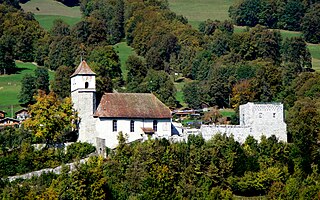
Obwalden or Obwald is one of the 26 cantons forming the Swiss Confederation. It is composed of seven municipalities and the seat of the government and parliament is in Sarnen. It is traditionally considered a "half-canton", the other half being Nidwalden.

Giswil is a municipality in the canton of Obwalden in Switzerland.

Iberg Castle is a ruined castle located on Iberg mountain in the municipality of Riniken in the canton of Aargau in Switzerland. Only a few remnants of the ruins are visible.

Clanx Castle is a ruined castle in the Appenzell District of the canton of Appenzell Innerrhoden in Switzerland.

The Rudenz Castle is a fortified tower in Flüelen, a municipality in the canton of Uri in Switzerland.

Attinghausen Castle is a ruined medieval castle in the municipality of Attinghausen in the canton of Uri in Switzerland. It is a Swiss heritage site of national significance.

Belfort Castle is a ruined castle in the municipality of Brienz/Brinzauls of the Canton of Graubünden in Switzerland. It is a Swiss heritage site of national significance.

Sogn Parcazi Castle and Church is a ruined castle and fortified church in the municipality of Trin of the Canton of Graubünden in Switzerland. It is a Swiss heritage site of national significance.

Jörgenberg Castle is a castle in the municipality of Waltensburg/Vuorz of the Canton of Graubünden in Switzerland. It is a Swiss heritage site of national significance.

Oberhofen Castle is a castle in the municipality of Oberhofen of the Canton of Bern in Switzerland. It is a Swiss heritage site of national significance.

Ringgenberg Castle is a castle in the municipality of Ringgenberg of the Canton of Bern in Switzerland. It is a Swiss heritage site of national significance.

The ruins of Grünenberg Castle, Schnabelburg Castle and Langenstein Castle are a complex of three interconnected castles on a hill above the municipality of Melchnau in the canton of Bern in Switzerland. The three castles formed the center of power of the Barons of Grünenberg in the Oberaargau region during the High Middle Ages.

Rosenberg Castle is a ruined castle located near the villages of Burghalden and Schachen to the north of the municipality of Herisau in the canton of Appenzell Ausserrhoden in Switzerland.

Rosenburg Castle is a ruined castle located to the west of the municipality of Herisau in the canton of Appenzell Ausserrhoden in Switzerland. It is a Swiss heritage site of national significance. The castle is on the Ramsenstock and is therefore also called Ramsenburg.

Rotzberg or Rotzburg is a ruined castle in the municipality of Ennetmoos in the canton of Nidwalden in Switzerland.

The Hexenturm is a stone tower in the municipality of Sarnen in the canton of Obwalden in Switzerland. It is a Swiss heritage site of national significance. The name refers to its use as a prison for suspected witches in the 17th century. Today it houses the Cantonal Archives of Obwalden.

Landenberg Castle is a ruined castle atop a hill in the municipality of Sarnen in the canton of Obwalden in Switzerland. In the 18th century an armory and firing range were built on the site. The Landenberg Armory is a Swiss heritage site of national significance. The ruins of the castle was the meeting place of the Landsgemeinde or Cantonal assembly for over three centuries.

Rudenz Castle is a ruined castle atop a hill in the municipality of Giswil in the canton of Obwalden in Switzerland. The castle and surroundings are a Swiss heritage site of national significance.

Wartau Castle is a ruined castle in the municipality of Wartau of the Canton of St. Gallen in Switzerland. It is a Swiss heritage site of national significance.

The Vorburg is a ruined castle located in the village of Oberurnen, now part of the municipality of Glarus Nord in the Canton of Glarus of Switzerland. It is the most significant castle in the canton.






















